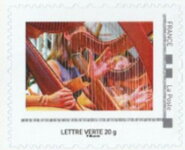Stamp: Lorient Interceltic Festival 2025. Harpists (France 2025)
Lorient Interceltic Festival 2025. Harpists (France 2025)
01 June (France ) within release Collector : Interceltic Festival Lorient 2025 goes into circulation Stamp Lorient Interceltic Festival 2025. Harpists face value Lettre No Face Value
| Stamp Lorient Interceltic Festival 2025. Harpists in catalogues | |
|---|---|
| Colnect codes: | Col: FR-COL 2025-19/3 |
Stamp is square format.
Also in the issue Collector : Interceltic Festival Lorient 2025:
- Souvenir Sheet - Lorient Interceltic Festival 2025 face value 8*LettreVerte20;
- Stamp - Lorient Interceltic Festival 2025. Cockney Hat face value Lettre;
- Stamp - Lorient Interceltic Festival 2025. Harpists face value Lettre;
- Stamp - Lorient Interceltic Festival 2025. Marine Drummers face value Lettre;
- Stamp - Lorient Interceltic Festival 2025. Poster face value Lettre;
- Stamp - Lorient Interceltic Festival 2025. Scots Dancers face value Lettre;
- Stamp - Lorient Interceltic Festival 2025. Scots Kilt face value Lettre;
- Stamp - Lorient Interceltic Festival 2025. Skirt face value Lettre;
- Stamp - Lorient Interceltic Festival 2025.Irish Dancing face value Lettre;
Stamp Lorient Interceltic Festival 2025. Harpists it reflects the thematic directions:
A festival is an event celebrated by a community and centering on some characteristic aspect or aspects of that community and its religion or cultures. It is often marked as a local or national holiday, mela, or eid. A festival constitutes typical cases of glocalization, as well as the high culture-low culture interrelationship. Next to religion and folklore, a significant origin is agricultural. Food is such a vital resource that many festivals are associated with harvest time. Religious commemoration and thanksgiving for good harvests are blended in events that take place in autumn, such as Halloween in the northern hemisphere and Easter in the southern.
Music is an art form and cultural activity whose medium is sound organized in time. The common elements of music are pitch (which governs melody and harmony), rhythm (and its associated concepts tempo, meter, and articulation), dynamics (loudness and softness), and the sonic qualities of timbre and texture (which are sometimes termed the "color" of a musical sound). Different styles or types of music may emphasize, de-emphasize or omit some of these elements. Music is performed with a vast range of instruments and vocal techniques ranging from singing to rapping; there are solely instrumental pieces, solely vocal pieces (such as songs without instrumental accompaniment) and pieces that combine singing and instruments. The word derives from Greek μουσική (mousike; "art of the Muses"). In its most general form, the activities describing music as an art form or cultural activity include the creation of works of music (songs, tunes, symphonies, and so on), the criticism of music, the study of the history of music, and the aesthetic examination of music. Ancient Greek and Indian philosophers defined music as tones ordered horizontally as melodies and vertically as harmonies. Common sayings such as "the harmony of the spheres" and "it is music to my ears" point to the notion that music is often ordered and pleasant to listen to.
A musical instrument is a device created or adapted to make musical sounds. In principle, any object that produces sound can be considered a musical instrument—it is through purpose that the object becomes a musical instrument. A person who plays a musical instrument is known as an instrumentalist. The history of musical instruments dates to the beginnings of human culture. Early musical instruments may have been used for rituals, such as a horn to signal success on the hunt, or a drum in a religious ceremony. Cultures eventually developed composition and performance of melodies for entertainment. Musical instruments evolved in step with changing applications and technologies.
A musician is an artist who composes, conducts, or performs music. According to the United States Employment Service, "musician" is a general term used to designate a person who follows music as a profession. Musicians include songwriters, who write both music and lyrics for songs; conductors, who direct a musical performance; and performers, who perform for an audience. A music performer is generally either a singer, who provides vocals, or an instrumentalist, who plays a musical instrument. Musicians may perform on their own or as part of a group, band or orchestra. Musicians can specialize in a musical genre, though many play a variety of different styles, depending on the cultures and backgrounds involved. A musician who records and releases music can be known as a recording artist.



